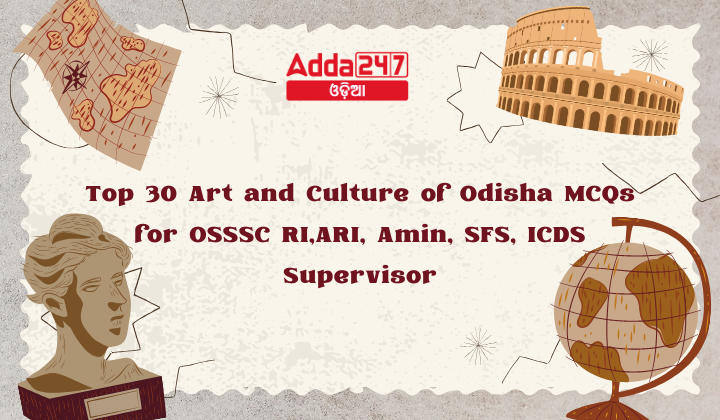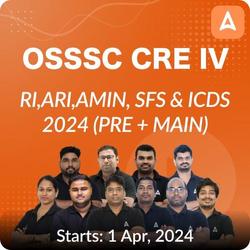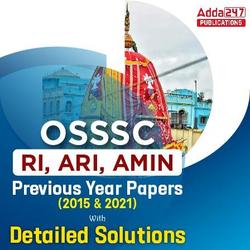Odisha, with its rich cultural heritage and vibrant artistic traditions, has always been a significant part of India’s cultural landscape. For aspirants preparing for various competitive exams such as OSSSC RI, ARI, Amin, SFS, ICDS Supervisor, having a comprehensive understanding of Odisha’s art and culture is crucial. To aid in your preparation, here are the top 30 multiple-choice questions (MCQs) covering various aspects of Odisha’s art and culture.
Top 30 Art and Culture of Odisha MCQs for OSSSC RI,ARI, Amin, SFS, ICDS Supervisor
- Where are the painted rock shelters from the prehistoric era primarily located?
a) Western part of Karnataka
b) Western part of Odisha
c) Northern part of Tamil Nadu
d) Southern part of Rajasthan
Answer: b) Western part of Odisha - What is the predominant theme depicted in these prehistoric rock paintings?
a) Religious rituals
b) Modern city life
c) Hunting, dancing, fighting, and domestic activities
d) Agricultural practices
Answer: c) Hunting, dancing, fighting, and domestic activities - What colors were used in these paintings, extracted from various sources?
a) Blue, green, and yellow
b) Red, white, and brown
c) Black, purple, and orange
d) Pink, turquoise, and gold
Answer: b) Red, white, and brown - Which script do the characters in these rock paintings resemble a mix of?
a) Indus Valley Civilization script
b) Egyptian hieroglyphs
c) Mohenjodaro and Brahmi scripts
d) Greek alphabet
Answer: c) Mohenjodaro and Brahmi scripts - Where can examples of these prehistoric paintings be found, depicting a procession scene of a king riding an elephant among other motifs?
a) Lakshmi temple in Odisha
b) Jagannath temple in Odisha
c) Ajanta caves in Maharashtra
d) Ellora caves in Maharashtra
Answer: b) Jagannath temple in Odisha - What is the primary subject matter of Saura paintings?
A) Tribal deities
B) Agricultural activities
C) Animals and nature
D) Mythological figures
Answer: A) Tribal deities - Which of the following tribal communities is associated with Kondh paintings?
A) Saura
B) Juang
C) Kondh
D) Paudi Bhuyan
Answer: C) Kondh - What are Kondh wall paintings known as?
A) Idital
B) Tikangkuda
C) Manji Gunda
D) Jhanjira
Answer: C) Manji Gunda - Which community’s paintings primarily depict the Samlai deity and agricultural activities?
A) Saura
B) Kondh
C) Paudi Bhuyan
D) Juang
Answer: C) Paudi Bhuyan - What themes are commonly depicted in Juang paintings?
A) Tribal deities
B) Agricultural activities
C) Birds, animals, and flowers
D) Mythological figures
Answer: C) Birds, animals, and flowers - What is the primary theme of Pattachitra paintings of Odisha?
A) Buddhist mythology
B) Hindu mythology
C) Islamic folklore
D) Tribal legends
Answer: B) Hindu mythology - Which village in Odisha is renowned for being the original hub of Pattachitra painters?
A) Bhubaneswar
B) Konark
C) Raghurajpur
D) Sonepur
Answer: C) Raghurajpur - When is the origin of Pattachitra art traced back to?
A) 1st century AD
B) 5th century BC
C) 10th century AD
D) 15th century AD
Answer: B) 5th century BC - Which mythical creature is depicted in the Navagunjara theme of Pattachitra?
A) Dragon
B) Griffin
C) Chimera
D) Nine different creatures
Answer: D) Nine different creatures - In which regions of Odisha did Pattachitra painting flourish?
A) Konark and Bhubaneswar
B) Puri and Chikiti
C) Paralakhemundi and Sonepur
D) All of the above
Answer: D) All of the above - What are Ganjapa playing cards in relation to Pattachitra?
A) Square shaped painted cards
B) Circular shaped painted cards
C) Rectangular shaped painted cards
D) Triangular shaped painted cards
Answer: B) Circular shaped painted cards - Who primarily prepares the canvas and applies colors in Pattachitra painting?
A) Men
B) Children
C) Women
D) Artisans
Answer: C) Women - What is the primary material used to prepare the canvas for Pattachitra paintings?
A) Paper
B) Cloth
C) Wood
D) Canvas
Answer: B) Cloth - How do artists create preliminary drawings in Pattachitra painting?
A) Pencil sketches
B) Charcoal sketches
C) Brush strokes
D) Stone etching
Answer: C) Brush strokes - Which festival is associated with the creation of Pattachitra paintings depicting Pith flowers and figures of charming women?
A) Diwali
B) Holi
C) Durga Puja
D) Jhulana
Answer: D) Jhulana - What is the traditional name for the type of pattachitra painting described in the passage?
a) Tala Pattachitra
b) Madhubani
c) Warli
d) Kalamkari
Answer: a) Tala Pattachitra - How are the images in Tala Pattachitra drawn on palm leaf?
a) Painted with watercolors
b) Carved into the palm leaf
c) Traced using black or white ink to fill grooves
d) Embroidered onto the palm leaf
Answer: c) Traced using black or white ink to fill grooves - What unique feature distinguishes Tala Pattachitra paintings from other forms of pattachitra?
a) They are painted on cloth
b) They are drawn on tree bark
c) They have superimposing layers with some areas left open to show a second image
d) They are drawn on canvas
Answer: c) They have superimposing layers with some areas left open to show a second image - Where are some examples of palm leaf manuscripts preserved?
a) Kolkata
b) Delhi
c) Bhubaneswar
d) Mumbai
Answer: c) Bhubaneswar - What material is used to create rows of equal-sized panels for Tala Pattachitra paintings?
a) Canvas
b) Paper
c) Palm leaf
d) Silk
Answer: c) Palm leaf - What is the name of the folk art form described in the passage?
A) Pattachitra
B) Jhoti or Chita
C) Warli
D) Madhubani
Answer: B) Jhoti or Chita - In which month do women folk in Odisha typically engage in decorating mud walls and floors with murals?
A) January
B) Margasira
C) May
D) September
Answer: B) Margasira - What is the primary purpose of creating Jhoti or Chita paintings?
A) Religious worship
B) Harvest celebrations
C) Cultural festivals
D) Historical documentation
Answer: A) Religious worship - Which of the following motifs are commonly used in Jhoti or Chita paintings?
A) Mountains and rivers
B) Cars and airplanes
C) Lotus, flowers, and elephants
D) Computers and smartphones
Answer: C) Lotus, flowers, and elephants - Besides mud walls and floors, where else are Jhoti paintings sometimes printed?
A) Canvas
B) Wood
C) Sarees
D) Metal plates
Answers: C) Sarees
















